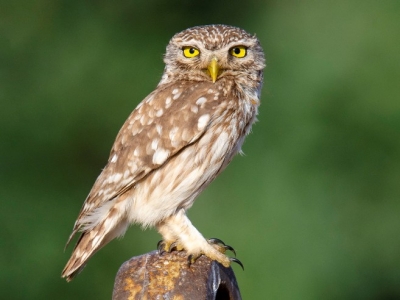
The little owl, or Athene noctua, is a small bird which belongs to the family Strigidae. Also called the owl of Athena or owl of Minerva, it is found in central Europe, Africa, India, China, Mongolia and Russia. In India it is found in Himachal Pradesh, Uttarakhand, West Bengal, Sikkim and Arunachal Pradesh.
It has long legs, yellow eyes and its plumage is grayish-brown and streaked with white. It weighs about 180 gms and has a wingspan of 56 cm. It has a large, flattish head, a round body and short tail. Its facial disc is flattened above the eyes and this, together with its white eyebrows give it a no-nonsense, stern expression!
It is a nocturnal bird and prefers a range of habitats that includes farmland, woodland edges, steppes and semi-deserts. It eats insects, worms and small mammals. These owls like to perch on branches and swoop down on their prey. They hoard surplus food in tree holes and are good vocalists with a variety of calls. The calls of the males are much clearer and sharper than the females.
The nesting sites are usually cavities in trees as well as holes in the walls of buildings. They are also known to accept nesting boxes for laying eggs. These owls are very neat and like to clean the cavity before laying eggs! Sometimes the same nest is used over and over again. It usually lays a clutch of around 4 eggs during the breeding season. The female takes charge of incubating the eggs while the male hunts for food and feeds her during this time. The incubation lasts 22 to 28 days. The owlets are cared for by both parents for about 3 months till they can fend for themselves and leave their home territory.
This owl species is listed under ‘Least Concern’ by the IUCN due to its wide range and stable population.
Picture Credit : Google




